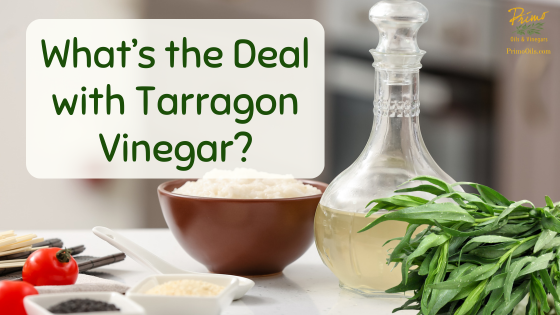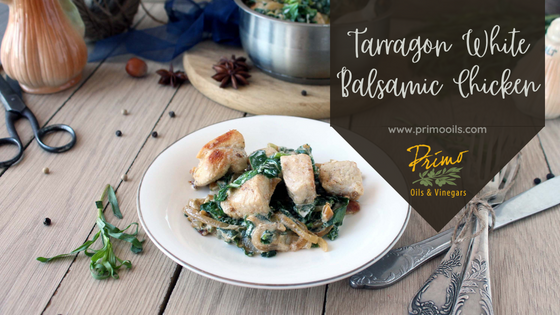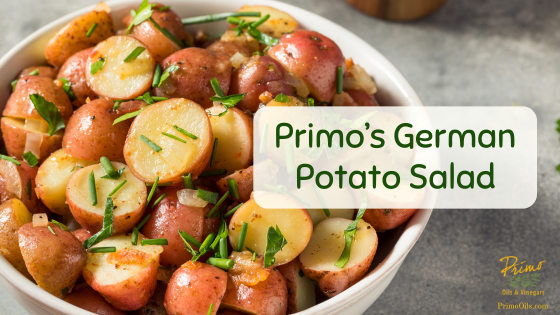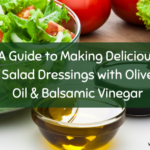If you’ve heard the buzz about tarragon vinegar, you might be wondering what to do with it. Here in Louisville, it’s a culinary staple increasingly beloved by both foodies and home cooks alike.
But what makes it so special, though?
In this article, Primo Oils and Vinegars will walk you through everything you need to know about this hearty infusion of white balsamic vinegar, plus recipes and answers to commonly asked questions.
What is tarragon?
Before we get into what makes tarragon vinegar so great in Louisville’s foodie scene, we have to understand its key ingredient first.
Tarragon is a fragrant, medicinal herb with a slightly sweet and savory flavor profile, often compared to anise, Sichuan peppercorns, basil, and even licorice. The exact taste can vary from person to person.
This herb thrives in summer, dying back to the ground over winter. However, if you bring it inside to protect it from frost or keep it under glass, the root will survive and return in the spring. A healthy tarragon plant typically lasts about three years.
Fun fact: French tarragon doesn’t grow from seeds—only from cuttings. This makes it a bit rarer to have as a cooking ingredient unless you have a dedicated garden or know an avid gardener who grows them.
What makes tarragon vinegar so popular?
Tarragon is an underused and underappreciated herb in American cooking, but some cuisines beg to differ. Another fun fact — in the late 2000s, this herb was a key ingredient in French cuisine, prized for its mild herbal notes while still having some “kick”.
Many upscale French restaurants in major cities around the country featured tarragon-infused dishes, but over the years, the herb fell out of favor, overshadowed by more commonly used herbs.
In Louisville, however, it’s a different story. The tarragon love never died down, and it’s still a beloved staple in many of our European-inspired recipes.
What makes tarragon so special here is its unrivaled versatility. It’s not only a simple way to elevate and complement simple dishes like salads; it can also be used as a substitute for a lot of white balsamic vinegars in many recipes.
In particular, tarragon vinegar pairs beautifully with creamy and rich flavors, making it a great complement to lamb, tuna, eggs, and poultry—especially poultry (more on this below).
Try Out These Tarragon Vinegar Recipes
Note: If it’s your first time cooking with tarragon vinegar, be mindful of its strong and complex flavor. Many home cooks make the mistake of using too much tarragon vinegar, which can overpower a dish instead of enhancing it. Use it sparingly to complement and elevate other ingredients.
Tarragon White Balsamic Chicken
Tarragon is best known for pairing with chicken. There’s even a famous French dish named after it —Poulet à l’estragon. Our Tarragon White Balsamic Chicken recipe brings together this signature vinegar with another star ingredient: Herbes de Provence olive oil.
Primo’s German Potato Salad
Tarragon vinegar is a fantastic addition to creamy salads. In our version of Louisville’s beloved German Potato Salad, we use tarragon vinegar to help cut through the richness of bacon and balance out the starchiness of the potatoes.
Try Out Primo’s Tarragon Vinegar Today
If you’ve made it all the way here, we take it you’re interested in adding a bottle to your pantry! We invite you to take a look at our tarragon vinegar. Available in 60 ml, 200 ml, 375 ml, and 750 ml sizes. Perfect for adding a fresh, herbal taste to your dishes and mixed drinks.
Frequently Asked Questions About Tarragon Vinegar
How long does tarragon vinegar last?
Unopened tarragon vinegar from our store can last for years when stored properly—ideally in a cool, dark place, such as a pantry, in a dark-tinted glass bottle.
Once opened, store-bought tarragon vinegar’s shelf life is about 1–2 years, while DIY versions last only around six months (which might be even less if the tarragon you used wasn’t properly cleaned before steeping in the vinegar). But with how delicious it is, it rarely lasts that long.
Can tarragon vinegar go bad?
Yes, it can. To check if your tarragon vinegar has gone bad, use the sniff-and-taste test. If it smells or tastes unusually strong, sharp, or unpleasant, it’s best to discard it.
Note: Don’t taste the tarragon vinegar if you see any visible signs of mold inside the bottle.
What’s a good tarragon vinegar alternative?
If you run out of tarragon vinegar and can’t make it to our store, you can whip up a quick substitute at home! Simply snip a few fresh tarragon leaves from your herb garden and steep them in white wine vinegar for a few weeks.
This homemade version works well in a pinch. If you find it too “overpowering” for your recipe, adding only white wine vinegar also works. If you need a replacement for tarragon vinegar ASAP, crush some fresh leaves and add them to apple cider vinegar.
Where do you buy tarragon vinegar?
Most tarragon vinegar sold in stores such as ours is made with the French variety. While there are two other well-known varieties (Mexican tarragon and Russian tarragon), most foodies believe they are far less flavorful than French tarragon.









